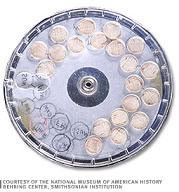‘The Pill’ Turns 46 Years Old
On May 9, 1960, the FDA approved Enovid, the first birth control pill, for clinical use Many court cases, a sexual revolution and a fundamentalist backlash later, use of and access to contraceptives is still very much a hot-button issue in the US Read a roundup of information and opinion relating to the release of an explosive report last week connecting a spike in unwanted pregnancies among the poor to decreased contraceptive use (h/t: Feministing) REPORT: A Tale of Two Americas for Women: The Contraception-Abortion Connection press release | PDF (Guttmacher Institute) Timeline: The Pill (PBS).
On May 9, 1960, the FDA approved Enovid, the first birth control pill, for clinical use. Many court cases, a sexual revolution and a fundamentalist backlash later, use of and access to contraceptives is still very much a hot-button issue in the U.S. Read a roundup of information and opinion relating to the release of an explosive report last week connecting a spike in unwanted pregnancies among the poor to decreased contraceptive use. (h/t: Feministing)
Your support matters…Guttmacher Institute Press Release:
Over the past three decades, widespread access to modern contraceptives and safe, legal abortion has helped tens of millions of American women take control of their lives and achieve more for themselves and their families. But a new report from the Guttmacher Institute shows that not all women are reaping these benefits.
The report, Abortion in Women?s Lives, documents a widening reproductive health gap between poor women and higher-income women. From the 1980s to the mid-1990s, women of all income groups became more likely to use contraceptives and less likely to experience unintended pregnancies. But since 1994, unplanned pregnancy rates among poor women have increased by 29%, while rates among higher-income women have decreased by 20%. Today, a poor woman is four times as likely to experience an unplanned pregnancy as a higher-income woman. link
Independent journalism is under threat and overshadowed by heavily funded mainstream media.
You can help level the playing field. Become a member.
Your tax-deductible contribution keeps us digging beneath the headlines to give you thought-provoking, investigative reporting and analysis that unearths what's really happening- without compromise.
Give today to support our courageous, independent journalists.






You need to be a supporter to comment.
There are currently no responses to this article.
Be the first to respond.